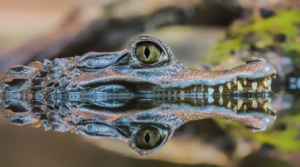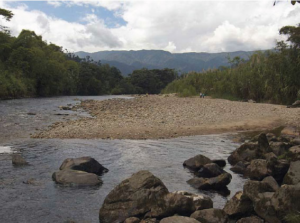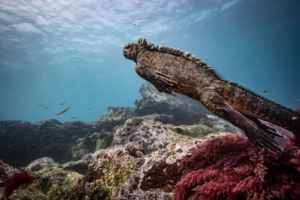Galapagos land iguanas, a remarkable species native to the Galapagos Islands, have long captivated the attention of nature enthusiasts. Situated in the vast Pacific Ocean, these islands hold a significant place in scientific history, having served as the breeding ground for Charles Darwin’s groundbreaking theory of evolution. Land iguanas can be found on the Santa Cruz, Isabela, Fernandina, Santiago, Baltra, North Seymour and South Plaza islands throughout the year. They possess remarkable adaptations that enable them to thrive in the challenging island environment, making them a symbol of resilience and natural beauty.
Appearance and Characteristics
Distinguished by their impressive size, Galapagos land iguanas can reach up to an astonishing length of 1.5 metres and weigh approximately 13 kilograms. Their dark brown or black coloration, complemented by their robust, scaly skin, serves as protection against the sun’s scorching rays and the unforgiving heat of their habitat. However, their ability to survive and endure extends beyond their physical appearance. More specifically, Galapagos land iguanas possess a unique adaptation that sets them apart from their reptilian counterparts – the ability to store water in their bladder. This remarkable feature allows them to efficiently conserve water and thrive even in arid, dry environments where water is scarce. Consequently, these creatures are able to navigate the challenges of their habitat and sustain themselves through periods of limited resources.
Diet and Feeding Habits
As herbivores, Galapagos land iguanas sustain themselves primarily on a diet of cacti, leaves, and fruit. The evolution of their feeding mechanism has equipped them with specialised tools to overcome the prickly nature of their preferred food sources. With their pointed teeth and strong jaws, they can effectively consume thorny plants. Moreover, their elongated, adhesive tongues enable them to efficiently gather and ingest food, ensuring their nutritional needs are met.
Behaviour and Reproduction
Galapagos land iguanas exhibit solitary and territorial tendencies. More specifically, male iguanas engage in a series of assertive behaviours, defending their territory and vying for the attention of potential mates during the mating season. Meanwhile, female land iguanas lay clutches of eggs, ranging from 2 to 20, which undergo an incubation period of approximately 3 to 4 months before hatching. This natural cycle ensures the continuation of their species, perpetuating the unique biodiversity that defines the Galapagos Islands.
Challenges and Conservation Efforts
Despite their emblematic status, Galapagos land iguanas have endured numerous threats to their existence. The impact of illegal hunting and introduction of invasive species, such as rats and goats, have disrupted their delicate ecosystem. These invaders compete with the land iguanas for vital resources, posing a significant challenge to their survival. However, dedicated conservation initiatives have given rise to a resurgence in the Galapagos land iguana population. Through vigilant efforts to preserve their habitat and protect them from harm, these remarkable reptiles have become a powerful symbol of the Galapagos Islands’ unrivalled beauty and unparalleled biodiversity.
Conclusion
Galapagos land iguanas represent the marvels of evolutionary adaptation and serve as a testament to the natural wonders found within the Galapagos Islands. With their unique traits, such as water storage capabilities, specialised feeding mechanisms, and territorial behaviours, these reptiles have carved their place in the ecological tapestry of their environment. Despite the challenges they face, the conservation efforts aimed at safeguarding their future ensure that these iconic creatures will continue to thrive, reminding us of the invaluable importance of preserving our planet’s precious biodiversity.

Descubriendo Galápagos (s,f)

El Universo (9 Julio 2012)




